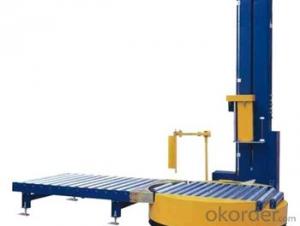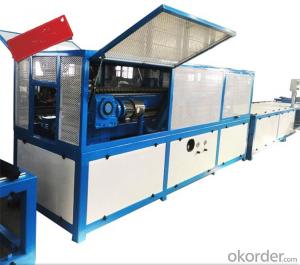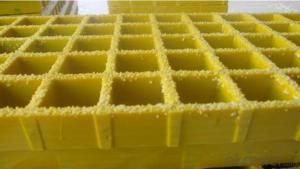FRP Pultrusion Profiles:FRP Pultruded Gratings with Excellent Electromagnetism Property - Latest Styles on Sale
- Loading Port:
- Tianjin
- Payment Terms:
- TT OR LC
- Min Order Qty:
- 55 m.t.
- Supply Capability:
- 50000 m.t./month
OKorder Service Pledge
OKorder Financial Service
You Might Also Like
Specification
COMPANT DESCRIPTION
CNBM,China National Building Materials Group is a state-owned enterprise in charge of administrative affairs in china building materials industry. Established in 1984, CNBM is a large group corporation of building materials with total assets of 25 billion RMB and a total staff of 30,000.CNBM now owns 200 subordinating firms of solely owned and joint-venture companies.
CNBM International Corporation is one subsidiary of CNBM, we focus on offering good-quality products,professional service and complete solution to our customers. Strong delivery capacity, advanced technology& management, strong financing capability and excellent after-sale service are our advantages in sharing international market.
FEATURES
a. Anti-corrosion and anti-rust
b. Light weight and high strength
c. Anti-flammable
d. Anti- fatigue
e. Safe and anti-slippery
f. Anti-ageing
g. Easy of maintenance
h. Excellent electromagnetism property
i. Good economic benefit
APPLICATION
Operation terrace,
stair walkway,
ground floor,
trench cover,
sidewalk,
foot bridge,
equipment safety fence,
scaffold
TECHNICAL DATA
Thickness (mm) | Bar width (mm) | Open space (mm) | Open rate (%) | Approx weight (kg/m |
25.4 | 15.2 | 22.8 | 60 | 13.2 |
25.4 | 15.2 | 15.2 | 50 | 15.9 |
25.4 | 15.2 | 10.1 | 40 | 18.5 |
25.4 | 40 | 10.8 | 21 | 14.5 |
38.1 | 15.2 | 22.8 | 60 | 15.8 |
38.1 | 15.2 | 15.2 | 50 | 19.1 |
38.1 | 15.2 | 10.1 | 40 | 22.4 |
IMAGES DETAILED



- Q: Can FRP pultrusion profiles be used in modular construction?
- Yes, FRP (Fiber Reinforced Polymer) pultrusion profiles can definitely be used in modular construction. FRP profiles are lightweight, high-strength, corrosion-resistant, and have excellent thermal and electrical insulating properties. These characteristics make them ideal for use in modular construction, where the emphasis is on prefabrication, transportation, and rapid assembly. The use of FRP pultrusion profiles in modular construction offers several advantages. First, their lightweight nature makes them easy to handle and transport, reducing logistical costs and effort. Second, their high strength-to-weight ratio ensures structural integrity while minimizing the overall weight of the modular components. This is particularly beneficial in applications where weight reduction is crucial, such as rooftop installations or areas with limited load-bearing capacity. Furthermore, the corrosion resistance of FRP profiles eliminates the need for regular maintenance and extends the lifespan of the modular construction. This is particularly advantageous in harsh environments, such as coastal areas or chemical processing facilities, where traditional construction materials like steel may deteriorate quickly. Additionally, FRP pultrusion profiles can be easily customized to meet specific design requirements. They can be manufactured in various shapes, sizes, and colors, allowing for flexibility in modular construction design. The profiles can also be easily integrated with other construction materials, such as concrete or wood, providing compatibility with existing modular systems. In summary, FRP pultrusion profiles are highly suitable for modular construction due to their lightweight, high strength, corrosion resistance, and customization capabilities. Their use in modular construction can enhance efficiency, reduce costs, and improve the overall performance and durability of modular buildings and structures.
- Q: Are FRP pultrusion profiles resistant to hail or impact damage?
- FRP pultrusion profiles exhibit exceptional resistance to both hail and impact damage. The incorporation of reinforcing fibers such as carbon or glass, along with a polymer resin matrix, grants these profiles unparalleled strength and durability. When compared to materials like wood, steel, or aluminum, FRP pultrusions offer significantly superior impact resistance. These profiles are specifically engineered to endure even the harshest environmental conditions, including hailstorms. The composite composition of FRP enables it to effectively absorb and distribute the energy generated by impacts, effectively preventing the formation of cracks or fractures. As a result, they are an ideal choice for various applications that necessitate protection against hail or impact damage, such as building facades, bridges, handrails, and utility poles. Moreover, FRP pultrusion profiles possess an impressive strength-to-weight ratio, meaning they can withstand heavy impacts without undermining their structural integrity. Furthermore, they are non-corrosive, making them impervious to rust or degradation caused by hail or impact. To summarize, the composite construction and exceptional strength-to-weight ratio of FRP pultrusion profiles render them highly resistant to hail or impact damage. They offer a reliable and long-lasting solution for applications that demand durability and resilience in the face of harsh environmental conditions.
- Q: Can FRP pultrusion profiles be used in the oil and gas industry?
- Yes, FRP (Fiber Reinforced Polymer) pultrusion profiles can be used in the oil and gas industry. These profiles offer excellent corrosion resistance, high strength-to-weight ratio, and low maintenance requirements, making them suitable for various applications in the industry such as pipe supports, cable trays, handrails, and platforms. Additionally, FRP pultrusion profiles are non-conductive, non-magnetic, and possess good fire-retardant properties, making them a safer alternative to traditional materials in hazardous environments.
- Q: How do FRP pultrusion profiles compare to traditional materials, such as steel or aluminum?
- FRP pultrusion profiles offer several advantages over traditional materials like steel or aluminum. Firstly, FRP profiles are much lighter in weight, making them easier to handle and install. Additionally, FRP profiles possess excellent corrosion resistance, making them a suitable choice for applications in harsh environments. They also have high strength-to-weight ratio, allowing for efficient load-bearing capabilities. Furthermore, FRP profiles are non-conductive and do not require any additional insulation, making them ideal for electrical applications. Lastly, FRP profiles are highly customizable, enabling the design of complex shapes and sizes. Overall, FRP pultrusion profiles provide a cost-effective, durable, and versatile alternative to traditional materials.
- Q: Can FRP pultrusion profiles be used in the construction of wastewater treatment tanks?
- Indeed, wastewater treatment tanks can effectively utilize FRP pultrusion profiles. These profiles are renowned for their exceptional strength-to-weight ratio, resistance to corrosion, and longevity, making them an optimal option for harsh environments such as wastewater treatment facilities. To manufacture FRP pultrusion profiles, continuous fibers like glass or carbon are drawn through a resin bath and subsequently through a heated die to attain the desired shape. This process yields profiles with consistent cross-sections and outstanding mechanical properties. In the construction of wastewater treatment tanks, FRP pultrusion profiles can serve various purposes. They can function as structural components, like beams, columns, and bracing systems, offering the necessary strength and rigidity to support the tank structure. Additionally, FRP profiles can reinforce concrete structures, bolstering their durability and resistance against chemical attack from the wastewater. Moreover, FRP pultrusion profiles can be engineered to endure the corrosive impact of the chemicals and gases found in wastewater treatment tanks. Unlike conventional materials such as steel or concrete, FRP exhibits a high resistance to corrosion, guaranteeing an extended service life and reduced maintenance expenses. Furthermore, FRP profiles provide advantages in terms of installation and transportation. They are lightweight, enabling easier handling and diminished labor requirements during construction. The modular nature of FRP profiles also facilitates swift assembly and disassembly, simplifying maintenance and modifications. Overall, incorporating FRP pultrusion profiles in the construction of wastewater treatment tanks offers numerous benefits, including superior strength, corrosion resistance, durability, and ease of installation. These advantages render FRP a dependable and cost-effective choice for wastewater treatment facilities.
- Q: Will the FRP section crack for a long time?
- As long as the design of the structure is reasonable and the quality of the product conforms to the design requirements, the normal use shall not be cracked.
- Q: Are FRP pultrusion profiles resistant to chemicals used in chemical plants?
- Yes, FRP (Fiber Reinforced Polymer) pultrusion profiles are generally resistant to a wide range of chemicals used in chemical plants. FRP materials are known for their excellent chemical resistance properties which make them suitable for various industrial applications including chemical plants. The manufacturing process of pultruded FRP profiles involves impregnating reinforcing fibers with a thermosetting resin, such as polyester, vinylester, or epoxy. These resins are chosen for their resistance to different chemicals and can be customized to meet specific requirements. FRP pultrusion profiles have demonstrated resistance to a range of aggressive chemicals including acids, bases, solvents, and corrosive gases. They are typically unaffected by most common chemicals found in chemical plants, which can include acids like sulfuric acid, hydrochloric acid, and nitric acid, as well as bases like sodium hydroxide. However, it is important to note that the resistance of FRP pultrusion profiles can vary depending on the specific resin system used and the concentration and temperature of the chemicals involved. It is always recommended to consult with the manufacturer or supplier to ensure that the chosen FRP profiles are suitable for the specific chemical environment in a chemical plant.
- Q: Are FRP pultrusion profiles UV resistant?
- FRP pultrusion profiles are known for their UV resistance. This is because manufacturers use a combination of polymer resin and reinforced fibers, like fiberglass, to create these profiles. These materials naturally possess UV resistant properties, which means that FRP pultrusion profiles can withstand prolonged exposure to sunlight and ultraviolet radiation without getting damaged. For outdoor applications, such as in construction, infrastructure, and marine industries, UV resistance is an important characteristic. However, it's worth noting that the level of UV resistance can vary depending on the specific resin and fiber composition used in the manufacturing process. To get precise information about the UV resistance of FRP pultrusion profiles for a specific application, it's advisable to consult the manufacturer or supplier.
- Q: Are FRP pultrusion profiles resistant to chemicals used in pharmaceutical packaging?
- FRP pultrusion profiles exhibit a general resistance to chemicals commonly employed in pharmaceutical packaging. These profiles are composed of a blend of reinforced fibers and a polymer resin matrix, resulting in exceptional resistance to chemical substances. The polymer resin utilized in FRP profiles is typically chosen to be compatible with a wide array of chemicals, including those typically used in pharmaceutical packaging. The remarkable chemical resistance of FRP profiles has led to their widespread utilization in various sectors, pharmaceuticals included. They can endure exposure to an extensive range of chemicals, such as acids, bases, solvents, and other aggressive substances frequently encountered in pharmaceutical packaging procedures. This resistance effectively safeguards the packaging's integrity and ensures that the pharmaceutical products remain free from contamination or degradation. Moreover, FRP pultrusion profiles also possess corrosion resistance, which proves advantageous in the pharmaceutical industry where aggressive chemicals may be present. This corrosion resistance further bolsters the durability and longevity of the FRP profiles, establishing them as a dependable choice for pharmaceutical packaging applications. Nonetheless, it is essential to recognize that the specific chemical resistance of FRP pultrusion profiles may vary depending on the type and concentration of chemicals employed. Therefore, it is advisable to consult the manufacturer or supplier of the FRP profiles to ascertain their compatibility with the specific chemicals used in pharmaceutical packaging.
- Q: Are FRP pultrusion profiles resistant to humidity or moisture?
- Yes, FRP pultrusion profiles are highly resistant to humidity or moisture due to their non-porous nature and the use of corrosion-resistant materials.
Send your message to us
FRP Pultrusion Profiles:FRP Pultruded Gratings with Excellent Electromagnetism Property - Latest Styles on Sale
- Loading Port:
- Tianjin
- Payment Terms:
- TT OR LC
- Min Order Qty:
- 55 m.t.
- Supply Capability:
- 50000 m.t./month
OKorder Service Pledge
OKorder Financial Service
Similar products
Hot products
Hot Searches
Related keywords

































